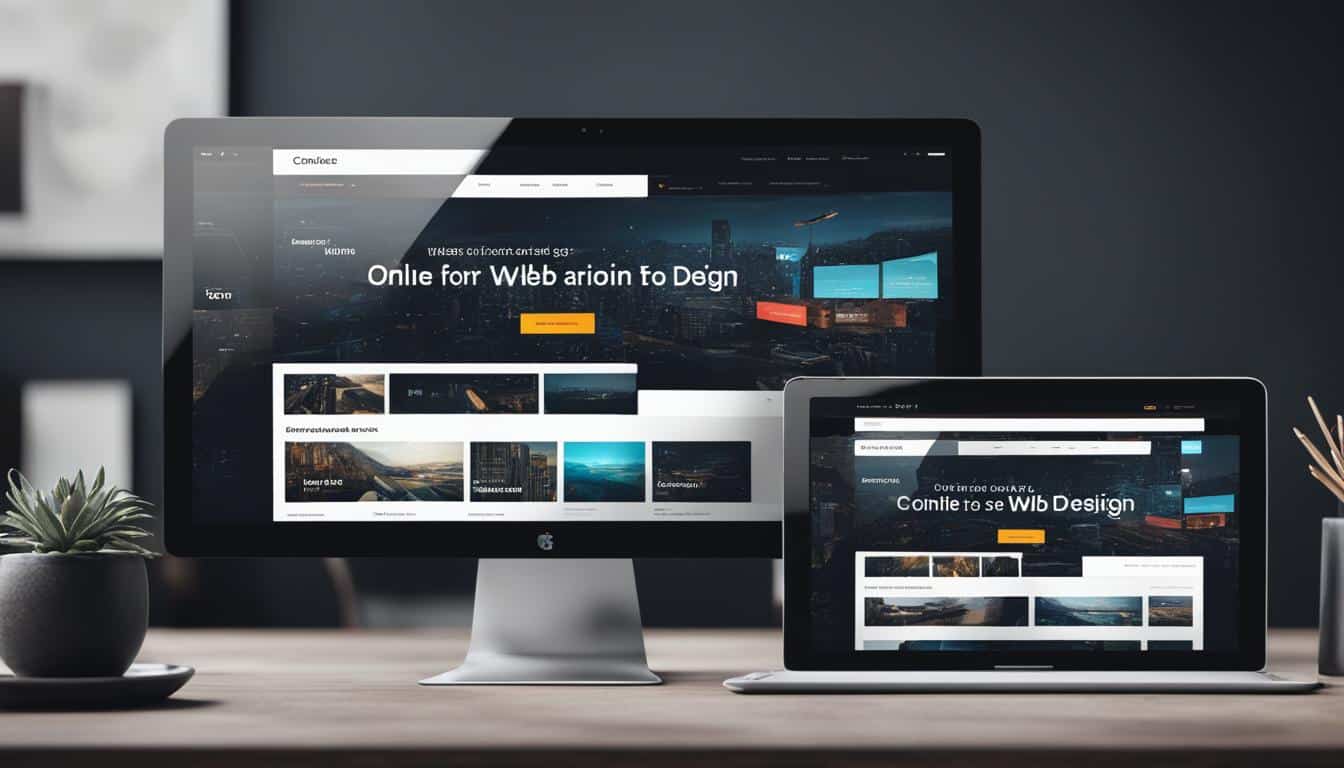In today’s digital landscape, the way we access and interact with websites has evolved. Mobile devices have become the primary means of browsing the internet, making it crucial for website owners to prioritize website responsiveness.
Having a responsive web design ensures that your website is mobile-friendly and compatible with various devices, such as smartphones and tablets. This means that your website will adapt and display seamlessly on any screen size or platform, providing a consistent and user-friendly interface to your visitors.
With cross-platform optimization and an adaptive layout, your website can deliver a fluid design that enhances the browsing experience, regardless of the device being used.
By investing in responsive website development, you will not only improve user experience but also stay ahead in search engine rankings. Search engines like Google prioritize mobile-friendly websites, rewarding them with higher visibility and better rankings.
Key Takeaways:
- Website responsiveness is crucial for providing a seamless user experience across devices.
- A responsive web design ensures your website is mobile-friendly and compatible with various devices.
- Adaptive layout and fluid design enhance user experience and navigation.
- Investing in responsive website development improves search engine visibility and rankings.
- A user-friendly interface leads to higher engagement and conversion rates.
Understanding the Importance of Mobile Optimization
Building a mobile-friendly website is no longer a luxury, but a necessity in today’s digital landscape. With over 50% of web traffic coming from mobile devices, it’s crucial to optimize your website for mobile users. Failing to do so can result in slow load speeds, distorted layouts, and high bounce rates.
Mobile optimization ensures a seamless and enjoyable experience for mobile users, ultimately increasing user engagement and driving conversions. By prioritizing mobile optimization, you are able to provide a mobile-friendly experience that caters to the needs and preferences of smartphone users. This not only enhances the overall user experience, but also improves your chances of converting those users into customers or leads.
Statistical data further emphasizes the significant role of mobile internet usage and the potential impact of mobile optimization on user behavior and conversion rates. For instance, research shows that 57% of users will not recommend a business with a poorly designed mobile site, while 68% of users are more likely to engage with a mobile-friendly website. These findings highlight the importance of creating a mobile-friendly experience that meets the expectations of your target audience.
“A mobile-friendly website is no longer a luxury – it’s a necessity.”
Mobile Optimization and User Engagement
Mobile optimization plays a crucial role in driving user engagement. When visitors have a positive experience on your mobile-friendly website, they are more likely to stay longer, explore multiple pages, and interact with your content. This increased user engagement not only signals to search engines that your website is valuable and relevant, but also increases the likelihood of conversions.
| Benefits of Mobile Optimization for User Engagement |
|---|
| Improved load speeds for quick access to content |
| Enhanced readability and visual appeal on mobile devices |
| Streamlined user interface for easy navigation |
| Optimized forms and checkout processes for smooth transactions |
By optimizing your website for mobile devices, you create an environment that is conducive to user engagement and encourages users to take the desired actions, such as making a purchase or filling out a contact form. Creating a mobile-friendly experience that caters to the preferences and needs of smartphone users is essential for maximizing user engagement and increasing conversions.

Stay tuned for the next section where we explore actionable strategies for implementing mobile optimization on your website.
Mobile Optimization Strategies
Implementing responsive web design is essential for mobile optimization. With responsive design, your website can adapt to different screen sizes and resolutions, providing a seamless user experience across devices.
Media queries are a powerful tool in mobile optimization. They allow you to adjust layout, font sizes, and image sizes based on the user’s device, ensuring optimal display and readability.
Optimizing page load speed is crucial for mobile-friendly design. Slow-loading pages can lead to user frustration and high bounce rates. By minimizing file sizes, leveraging caching techniques, and reducing HTTP requests, you can improve performance and provide a faster browsing experience.
Image optimization is another key aspect of mobile optimization. Compressing images without compromising quality can significantly reduce page load times. Optimizing alt text and image attributes ensures accessibility and improves SEO.
Simplified navigation plays a vital role in creating a mobile-friendly website. With limited screen space, it’s crucial to provide a streamlined and intuitive navigation menu that enables easy access to information.
Key Takeaways:
- Responsive web design allows your website to adapt to different devices, ensuring a user-friendly experience.
- Media queries help adjust the layout, font sizes, and image sizes to cater to specific device requirements.
- Optimizing page load speed improves performance and enhances user experience.
- Image optimization reduces file sizes to improve load times and SEO.
- Simplified navigation ensures easy access to information on mobile devices.

| Mobile Optimization Strategies | Benefits |
|---|---|
| Responsive Web Design | Adapts to different devices and provides a seamless user experience |
| Media Queries | Adjusts layout and font sizes based on device requirements |
| Page Load Speed Optimization | Improves performance and reduces bounce rates |
| Image Optimization | Reduces file sizes for faster load times and improved SEO |
| Simplified Navigation | Enhances usability and improves user engagement |
Using Mobile-Friendly Testing Tools
To ensure that your website is optimized for mobile users, it’s important to use mobile-friendly testing tools. These tools allow you to assess how your site performs on different devices and screen sizes, identifying potential issues that may hinder user experience. Regularly testing your site with these tools will ensure that it provides an optimal user experience on all devices.
Google’s Mobile-Friendly Test
One of the most widely used mobile-friendly testing tools is Google’s Mobile-Friendly Test. This tool analyzes your website’s responsiveness and provides suggestions for improvement. By simply entering your website URL, Google’s Mobile-Friendly Test will evaluate your site’s mobile compatibility and highlight any issues that need to be addressed.
BrowserStack’s Mobile Device Testing
Another valuable mobile-friendly testing tool is BrowserStack’s Mobile Device Testing. This tool allows you to view your website on various virtual devices, enabling you to identify any display or functionality issues. By simulating different mobile devices, BrowserStack’s Mobile Device Testing helps you ensure that your website is optimized for a wide range of screen sizes and operating systems.

Regularly testing your website with mobile-friendly testing tools is crucial for website optimization and providing a seamless user experience on all devices.
By utilizing mobile-friendly testing tools like Google’s Mobile-Friendly Test and BrowserStack’s Mobile Device Testing, you can identify and address any mobile optimization issues, ensuring that your website is user-friendly and accessible to mobile users.
Google Prioritizes Mobile-First
With the increasing dominance of mobile devices in the digital landscape, it is no surprise that Google has adopted a mobile-first approach. Google’s algorithm now prioritizes websites that are mobile-responsive and provide a user-friendly experience across all devices.
“It’s crucial for websites to be optimized for mobile devices and adopt responsive web design. This ensures that users can easily access and navigate the site, leading to higher engagement and improved search rankings.”
By implementing a mobile-first strategy, your website is more likely to rank higher in search results and attract a larger audience. Mobile-responsive web design allows your site to adapt to different screen sizes and resolutions, providing a seamless and user-friendly experience for mobile users.
Benefits of a Mobile-First Approach
Adopting a mobile-first approach offers several advantages for your website:
- Improved visibility in search results
- Enhanced user experience across all devices
- Better accessibility for mobile users
- Higher user engagement and longer visit durations
Mobile-Responsive Web Design
To meet the expectations of Google’s mobile-first algorithm, it is essential to implement a mobile-responsive web design. This approach ensures that your website automatically adjusts its layout and content to fit the user’s device, whether they are using a smartphone, tablet, or desktop computer.
By utilizing media queries, you can customize the appearance of your website based on the screen size and resolution of the user’s device. This ensures that your content is displayed optimally, with easy-to-read text and appropriately sized images. A mobile-responsive design creates a seamless user experience, reducing the need for excessive scrolling or zooming.
Furthermore, a mobile-responsive website eliminates the need for separate mobile and desktop versions, simplifying maintenance and avoiding duplicate content issues.
User-Friendly Experience
A mobile-first approach emphasizes the importance of providing a user-friendly experience for mobile users. It encourages website owners to prioritize factors such as fast page load speeds, simplified navigation, and easy access to important information.
By focusing on creating a user-friendly experience, you can increase user satisfaction, reduce bounce rates, and improve overall engagement. This, in turn, can lead to higher conversion rates and better business results.
Google’s Mobile-First Indexing
Google’s mobile-first indexing means that the mobile version of your website will be the primary factor in determining how your site is ranked in search results. It is crucial to ensure that your mobile version provides the same high-quality content and user experience as your desktop version, or you risk a decline in search rankings.

| Benefits of Mobile-First Approach | Statistics |
|---|---|
| Improved visibility in search results | 70% of mobile searches lead to an action within an hour |
| Enhanced user experience across all devices | 85% of adults think a company’s mobile website should be as good or better than their desktop website |
| Better accessibility for mobile users | 90% of mobile searches result in a purchase or visit to a business |
| Higher user engagement and longer visit durations | Mobile users spend an average of 69% of their media time on smartphones |
Improved Usability and Customer Experience
Mobile optimization plays a crucial role in enhancing the usability and customer experience of websites. By implementing a responsive web design, businesses can ensure that their website loads quickly, provides easy access to information, and offers seamless navigation. These improvements contribute to increased user engagement, longer time on page, and better overall satisfaction.
A study by Google found that 53% of mobile users will abandon a website if it takes longer than 3 seconds to load. By optimizing your website for mobile devices, you can significantly reduce load times and prevent potential visitors from bouncing off your site. This improved speed not only enhances the user experience but also positively impacts search engine rankings.
Providing a user-friendly interface is essential for mobile optimization. With the limited screen space on mobile devices, it’s important to prioritize the accessibility and visibility of key information. By designing a responsive layout that adapts to different screen sizes, you can ensure that users have a seamless browsing experience. This includes optimizing font sizes, ensuring proper spacing between elements, and using intuitive navigation menus that are easy to locate and use.
The time users spend on a page is a key metric for measuring engagement and the effectiveness of your content. By enhancing the usability of your website through mobile optimization, you can keep users engaged for longer periods. This can be achieved by providing clear and concise content, utilizing engaging visuals, and incorporating interactive elements that encourage users to explore further.
“Mobile optimization improves the overall usability and customer experience of a website, making it easier for users to find information quickly and navigate seamlessly.”
The ability to easily access information on a mobile device leads to a better customer experience. Whether users are looking for product details, contact information, or customer support, a responsive website ensures that the information is readily available and easy to find. This seamless experience builds trust and satisfaction, increasing the likelihood of conversions and repeat visits.
Mobile optimization goes beyond just adapting your website to different screen sizes. It improves user experience, reduces bounce rates, and increases engagement. By prioritizing improved usability and customer experience, businesses can create a positive online presence that attracts and retains more users, resulting in better overall success.
Improved Page Speed and Lower Bounce Rate
Page speed is a crucial factor that impacts user experience and search rankings. Slow loading websites lead to high bounce rates and unsatisfied users. Optimizing page speed for mobile devices is essential for creating a seamless browsing experience and reducing bounce rates.
Users expect websites to load quickly, especially on mobile devices where data speeds may vary. A fast-loading website ensures that users can access information promptly and navigate through your content without frustrating delays. It improves overall user satisfaction and encourages them to stay longer on your site, decreasing the likelihood of bouncing back to search results.
To optimize page speed, you need to consider various elements, such as optimizing image sizes and minimizing HTTP requests. Compressing images without compromising quality and reducing the number of requests made to the server can significantly improve load times. Additionally, optimizing code, leveraging browser caching, and enabling HTTP/2 can further enhance page speed and user experience.
Mobile responsiveness is another critical aspect for improving page speed and reducing bounce rates. Having a mobile-responsive design ensures that your website adapts seamlessly to different screen sizes and devices. Users can easily access and navigate your content on their preferred mobile device, leading to longer visit durations and increased engagement.
Benefits of Improved Page Speed and Lower Bounce Rate
| Benefits | Description |
|---|---|
| Enhanced User Experience | A fast-loading website provides a smooth and enjoyable browsing experience, improving user satisfaction and increasing the chances of conversion. |
| Reduced Bounce Rate | By optimizing page speed and mobile responsiveness, you can reduce bounce rates, keeping visitors engaged and encouraging them to explore your website. |
| Improved Search Engine Rankings | Google considers page speed as a ranking factor. A faster website can positively impact your search engine rankings, improving visibility and organic traffic. |
| Increased Conversion Rates | Providing a fast and efficient user experience can boost conversion rates by reducing friction and encouraging users to take desired actions, such as making a purchase or filling out a form. |
| Improved Mobile Experience | Mobile responsiveness ensures that your website is optimized for mobile devices, catering to the growing number of mobile users and their browsing habits. |
Furthermore, providing high-quality content that is relevant, informative, and engaging is crucial for retaining visitors and reducing bounce rates. When users find valuable and helpful content, they are more likely to stay longer on your website, explore different pages, and take meaningful actions.
By focusing on page speed optimization, mobile responsiveness, and offering high-quality content, you can significantly improve your website’s performance, user satisfaction, and ultimately drive better results for your online business.
Avoid Duplicate Content and Increase Social Shares
Duplicate content can pose a significant issue for websites that have separate versions for mobile and desktop users. However, by adopting a mobile-friendly design, you can eliminate this problem and ensure a single, optimized version of your website that avoids confusion for both search engines and users.
Implementing a mobile-responsive design allows your website to adapt seamlessly to different screen sizes, providing a consistent and user-friendly experience across devices. This not only enhances user engagement but also prevents duplicate content concerns that may arise from having separate mobile and desktop versions of your site.
Moreover, a mobile-friendly design plays a crucial role in increasing audience engagement and social shares. With more and more users accessing the internet via mobile devices, having a website that is easy to navigate, read, and interact with on a mobile screen encourages users to engage with your content. This, in turn, leads to higher social shares as users are more likely to share enjoyable and user-friendly experiences with their networks.
Creating mobile-friendly and shareable content is essential for increasing your website’s visibility and reach. By optimizing your website for mobile and encouraging social shares, you can drive more traffic to your site and boost your overall SEO success.
Mobile-Friendly Design Checklist:
| Key Elements | Description |
|---|---|
| Responsive Layout | Ensure your website layout adjusts seamlessly to different screen sizes, providing a consistent user experience. |
| Optimized Images | Compress and optimize images to reduce page load times and improve mobile performance. |
| User-Friendly Navigation | Simplify your website’s navigation menu for easy access to information on smaller screens. |
| Readable Font Sizes | Choose font sizes that are legible on mobile devices without requiring users to zoom in. |
| Fast Page Load Speed | Optimize your website’s performance to ensure fast loading times on mobile devices. |
| Seamless Social Sharing | Integrate social sharing buttons to make it easy for users to share your content on social media platforms. |
By following this mobile-friendly design checklist, you can create an optimized website that avoids duplicate content issues while increasing social shares and audience engagement. Implementing these strategies will not only enhance your website’s visibility and ranking but also provide a seamless user experience across devices, contributing to your overall online success.
Website Responsiveness and Mobile Optimization: Key Factors for Success
In today’s mobile-dominated world, ensuring website responsiveness and mobile optimization are crucial for achieving online success. By prioritizing responsive web design, optimizing page load speed, and enhancing user experience, you can create a seamless and enjoyable browsing experience for mobile users.
Website owners who prioritize mobile optimization not only increase user engagement and conversion rates but also improve search rankings and overall online visibility. With the majority of web traffic coming from mobile devices, it’s essential to adapt to the ever-evolving digital landscape.
To achieve optimum results, focus on implementing responsive web design that adjusts seamlessly across different screen sizes and resolutions. Additionally, optimizing page load speed, simplifying navigation, and delivering high-quality content are paramount for a positive user experience and improved search rankings.
Prioritizing mobile optimization is key to staying ahead in the competitive online landscape. By adapting your website to be mobile-friendly and ensuring a smooth browsing experience, you can attract and retain more users, increase conversions, and ultimately achieve greater online success.
FAQ
What is website responsiveness?
Website responsiveness refers to the ability of a website to adapt and provide an optimal viewing experience across different devices, such as desktops, smartphones, and tablets. It ensures that the website layout, content, and features are easily accessible and functional, regardless of the device being used.
Why is responsive web design important?
Responsive web design is essential because it allows your website to provide a seamless user experience across various devices. It ensures that your website is mobile-friendly, improves user engagement, reduces bounce rates, and helps improve search engine rankings.
How does mobile optimization impact user engagement?
Mobile optimization plays a significant role in user engagement. When your website is optimized for mobile devices, users can easily access and navigate your site, resulting in longer visit durations, increased page views, and improved user engagement.
How can I implement responsive web design?
To implement responsive web design, you can use media queries to adjust the layout, font sizes, and image sizes based on the user’s device. It’s also crucial to optimize page load speed, reduce image sizes, minimize HTTP requests, and simplify navigation to create a mobile-friendly website.
What are some mobile-friendly testing tools?
There are several mobile-friendly testing tools available, including Google’s Mobile-Friendly Test and BrowserStack’s Mobile Device Testing. These tools allow you to assess how your website performs on different devices and screen sizes, helping you identify potential issues and improve user experience.
How does Google prioritize mobile-first?
Google has adopted a mobile-first approach, which means that it prioritizes websites that are optimized for mobile devices. By having a mobile-responsive web design, you can improve your website’s visibility and ranking in search results, resulting in increased organic traffic.
How does mobile optimization improve usability and customer experience?
Mobile optimization improves usability and customer experience by making websites faster, more accessible, and easier to navigate on mobile devices. A responsive web design ensures that users can quickly find information, leading to higher engagement, longer time on page, and improved customer satisfaction.
How does mobile optimization impact page speed and bounce rate?
Mobile optimization is crucial for improving page speed, reducing bounce rates, and creating a seamless browsing experience. Slow-loading websites result in high bounce rates and unsatisfied users. By optimizing page speed for mobile devices, you can provide a fast and user-friendly mobile experience, resulting in longer visit durations and increased engagement.
How does mobile optimization help avoid duplicate content and increase social shares?
By adopting a mobile-responsive design, you can avoid duplicate content issues that can arise from separate mobile and desktop versions of your website. Additionally, a mobile-friendly design makes it easier for users to engage with your content and share it on social media platforms. This can lead to increased social shares, audience reach, and overall SEO success for your website.
Why are website responsiveness and mobile optimization important?
Website responsiveness and mobile optimization are vital for success in today’s mobile-dominated world. By prioritizing responsive web design, optimizing page load speed, and improving user experience, website owners can create a seamless and enjoyable browsing experience for mobile users. This not only increases user engagement and conversion rates but also improves search rankings and overall online visibility.





